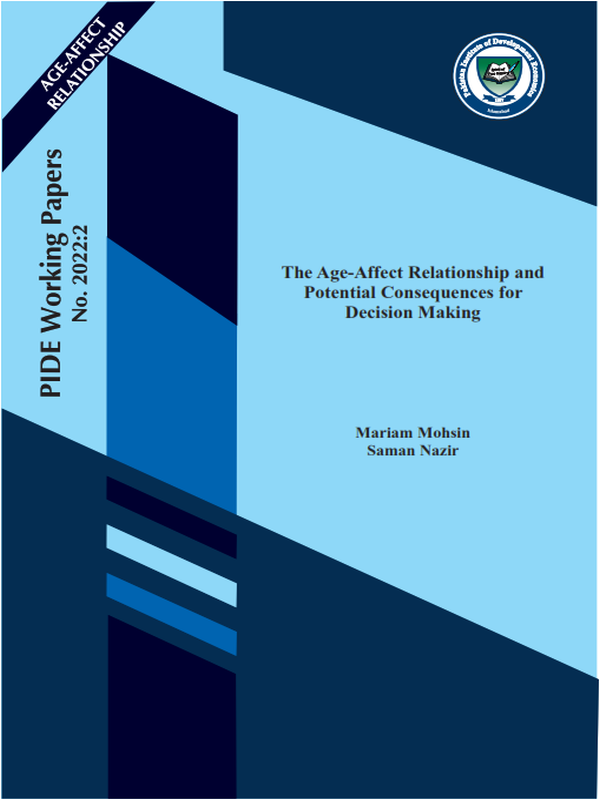
Pakistan Institute of Development Economics
- Home
Our Portals
MenuMenuMenuMenuMenuMenuMenu - ResearchMenuMenuMenuMenuMenuMenuMenu
- Discourse
- The PDR
- Our Researchers
- Academics
- Degree Verification
- Thesis Portal
- Our Portals
The Age-Affect Relationship and Potential Consequences for Decision Making
This paper studies age and aging as potential variables of interest in applied psychology and management science. The paper is divided into two analytical parts. The first part discusses aging in relation to emotional control processes and potential implications and tries to explain how older adults deal with negativity and loss while regulating well-being. The second part discusses the literature that deals with outcome variables, such as performance and underlying determinants of performance like motivation and arousal and their potential relationship with aging.
The discussion includes a synthesis of how emotion-regulation among older adults relates to the age-performance linkage and the interceding motivational mechanisms involved. The discussion section also highlights missing links in the literature and provides recommendations for further research in the area.
INTRODUCTION
Age is an important variable provided its omnipresence across all organisational situations and requires rigorous research attention. However, it has been given little attention in applied psychology and management science literature with many experimental, empirical, and meta-analytic studies treating age as a control variable. Rarely has it been given attention as a variable of interest.
Improved health facilities and more sophisticated medical treatments for previously terminal diseases have caused life expectancy to increase worldwide. This also means the global workforce is aging. By 2007, 18.4 million workers in the United States were 55 years or older, representing 13 percent of the country’s workforce (Avery, McKay & Wilson, 2007). By 2015, this number was expected to rise to 31.9 million, or approximately 20 percent (U.S. General Accounting Office, 2001). Similarly, 41 percent of the Canadian workforce is projected to be between 45 and 64 by 2021 (Lende, 2005). Thirty percent of workers in the United Kingdom are over 50 years of age (Dixon, 2003). Similarly, the older population in Pakistan, which currently stands at 12.5 million, is expected to be double by 2030. It is estimated that the older population will reach 40 million by 2050 (Zaidi, et al. 2019, p. 60).
Despite the changing demographic trends of the workforce, most organizations are little prepared to meet the challenges associated with these changes (Hedge, Borman & Lammlein, 2006). Suitability of jobs and jobs environment to chronological age is a significant concern to address. In countries where the aging workforce is combined with high birth rates and availability of a young workforce, it becomes an even more important question to investigate.
The focus of this paper is to study the differences across older and younger individuals in their cognitive control processes that have potential implications for further research.
Within the literature on employment and aging, the term older adult has been used for employees ranging from 40 to 75 years of age, depending upon the field as well as the purpose of the study. In terms of the labor market, the term generally refers to employees over 50-55 years. 2 This threshold is selected because this age bracket features a decline in workforce activities (Kooij, 2008).
Our approach in this paper is primarily speculative and analytic. The first part of the paper discusses aging in relation to emotional control processes and potential implications and explains how older adults deal with increasing amounts of negativity, losses, and pain, without significantly suffering low levels of happiness and well-being. The second part discusses the literature that deals with outcome variables of the aging process like performance and underlying determinants of performance like motivation and arousal and their potential relationship with aging. The discussion includes a synthesis of how emotion-regulation among older adults relates to the age-performance linkage, and the interceding motivational mechanisms involved. The discussion section also highlights missing links in the literature and provides recommendations for further research in the area.



